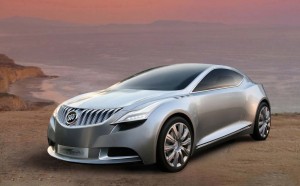Ford and General Motors are charging forward into the past this week at the Shanghai Auto Show, reviving two once-familiar nameplates in a bid to build market share in what has become the world’s largest automotive market.
The Ford Escort and Buick Riviera are just concept vehicles for now, but both offer hints of what the two U.S. manufacturers may have in store for Chinese consumers. Indeed, once little more than a backwater event, the Shanghai gathering is this year one of the world’s most significant car shows, with dozens of new vehicles making their global debut there.
And for good reason – by at least one estimate, the Chinese automotive market could soon be larger than the U.S. and European markets combined. By 2022, forecast senior GM officials, sales in the People’s Republic could top 35 million annually. That’s more than double the peak hit in the American market nearly a decade ago.
No surprise, then, that Tim Lee, the president of GM’s International Operations, told reporters that, “No market is more critical than the China market for us.”
Increasingly, you’ll hear the same thing from other manufacturers, whether Volkswagen, Toyota or Ford. And they’re backing that up by using the Shanghai Auto Show to reveal some of their latest products. Among the new models debuting in China’s second-largest city this week are:
- The Buick Riviera Concept, a futuristic show car that “offers a preview of Buick’s future design language,” suggested Shanghai GM President Ye Yongming;
- The Ford Escort, a lower-priced take on the popular Ford Mondeo (the latter known to Americans as the Fusion). A production version would target first-time family buyers in smaller cities;
- The Volkswagen iBeetle, which adds a specially developed iPhone docking station and app to provide an array of new infotainment features;
- The Acura Concept SUV-X, which is likely to reappear as a compact entry-luxury crossover.
The Acura show car is just one of an assortment of high-line models on display in Shanghai. China is already the largest outlet for several luxury automakers and it is expected to overtake the U.S. market before decade’s end to become the world’s largest luxury car market.
That prompted Mercedes-Benz to head to Shanghai with its new GLA Concept, while BMW took the wraps off its new X4 coupe-crossover. Maserati also weighed in with its sporty Ghibli sedan.
(Check out the new Mercedes-Benz GLA Concept. Click Here.)
Porsche was also on hand with the global debut of the new Panamera S E-Hybrid, the German marque’s first plug-in hybrid. That’s no surprise considering China’s increasing focus on battery power.
(Porsche plans new plug-in Panamera. Click Here for more.)
“The Chinese could create the inflection point that transforms the battery car into a viable reality,” David Cole, chairman-emeritus of the Center for Automotive Research, recently told TheDetroitBureau.com.
That’s because of the growing concern about air pollution problems that have become a constant threat in cities like Shanghai and Beijing. While the heavy dependence on coal power is a major factor, the surge in car sales has also come under the microscope. Chinese bureaucrats have ramped up the incentives offered to buyers of qualified electric vehicles, in some cases to more than $20,000.
Pollution – along with increasing congestion in key cities like Beijing — is the wild card that could short-circuit China’s automotive market. In a recent report, Jun Ma, chief Chinese economist for Deutsche Bank, warned that the government could take several steps that include “constraining auto ownership growth.”
There are some who fear that the Beijing government could sharply limit auto sales or even force a wholesale shift to electric power. Critics counter that with its heavy dependence on coal generators, however, electric vehicles might actually worsen the country’s environmental problems.
Even if those scenarios don’t play out, the near-term situation is far from certain. The overall Chinese economy has cooled significantly in recent months and, for now, at least, the era of strong double-digit sales growth in the automotive market appears to be over.
Some makers are doing better than others. GM, long locked in a battle for market dominance with VW, was up nearly 10% during the first quarter, setting an all-time record in the process.
Toyota is barely achieving half that growth after a 4.9% increase in 2012. Japanese marques, in general, continue to suffer as the result of an ongoing dispute over a chain of uninhabited islands claimed by both Japan and China.
“Our original expectation was for sales to come back in half a year, but now our plan is to push harder after our new product introductions in the fall,” Toyota’s senior Chinese executive Hiroji Onishi, said in Shanghai. “We’ll be focusing more on inland areas and also the younger generation.”
While luxury cars clearly have a market in China, many industry analysts stress that the real growth in years ahead will come from first-time buyers in second, third and fourth-tier cities just beginning to feel the benefits of the Chinese economic boom. With a population estimated around 1.5 billion, that would be enough to keep the momentum of the last decade going – or so automotive planners are hoping as they watch the public’s response to the new products on display this week in Shanghai.

